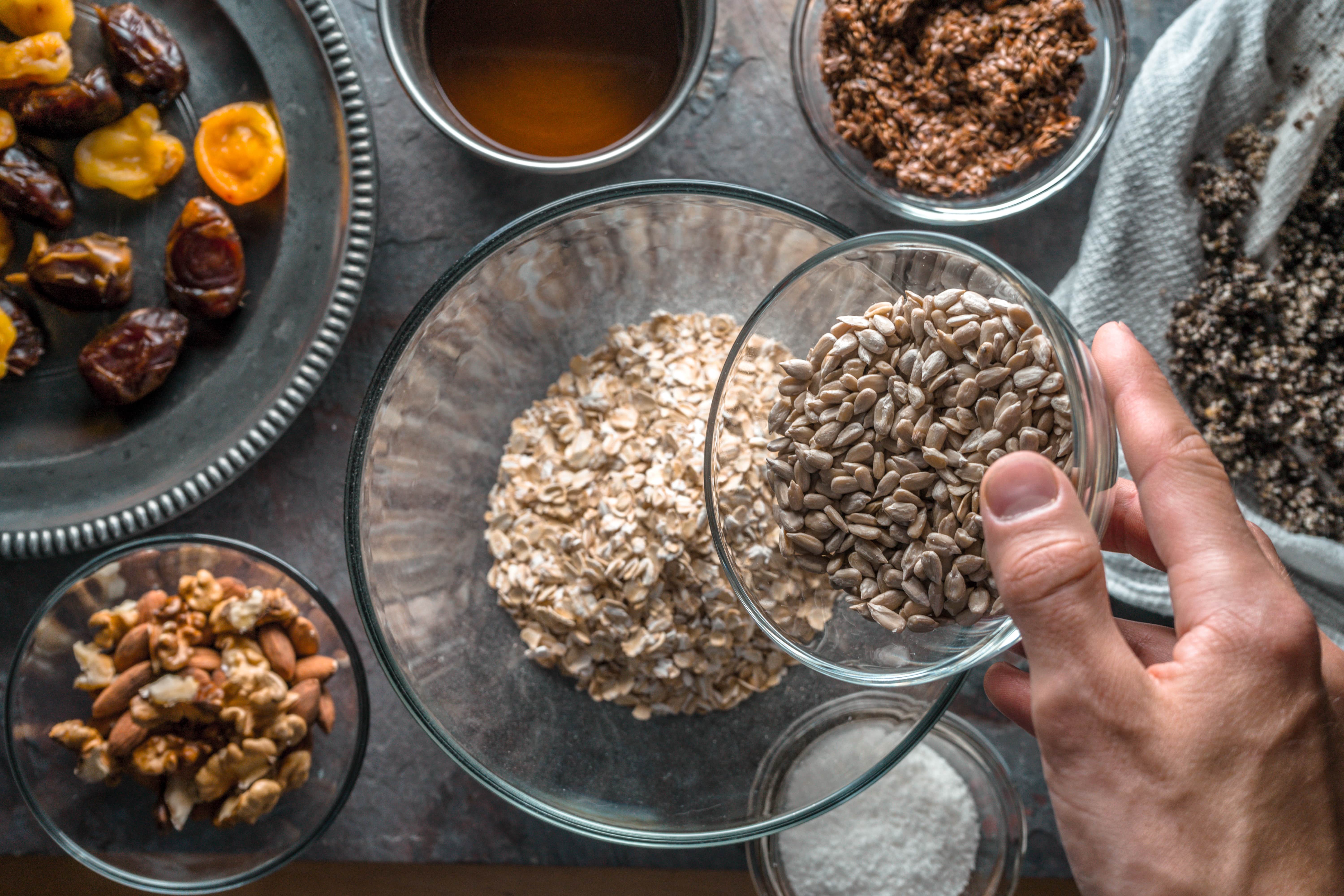Fiber is the non-digestible part of carbohydrates. Fiber doesn’t offer calories; instead, it provides several mechanical benefits throughout the digestion process.
Getting enough fiber in your diet can be difficult if you rely on ultra-processed or processed foods. To help meet your daily fiber goals, you should aim to include fiber-rich foods from as many food groups as possible.
How Fiber Can Help With Weight Loss
Regularly including fiber in your diet can help with weight loss.1 Scientists believe fiber has a multi-faceted effect on weight loss by:
- Promoting greater satiety at meals
- Helps slow the absorption of carbohydrates
- Positively altering the secretion of gut hormones involved in weight management
<p class="pro-tip"><strong>Read more about </strong><a href="/blog/high-fiber-low-carb-foods">high-fiber, low-carb foods for weight loss</a></p>
Types of Fiber That Can Help With Weight Loss
There are two types of fiber predominantly found in the diet: insoluble fiber and soluble fiber. You can imagine insoluble fiber as a type of food that holds its shape despite being in water, such as a raw carrot stick. In contrast, when soluble fiber is added to a cup of water it will absorb the liquid and change in consistency, such as oatmeal becoming mushy.
Insoluble and soluble fiber are both naturally present in different foods, and they are both required for good health. But soluble fiber has more research to support its role in weight management and weight loss.
Common sources of soluble fiber:
Data from: The Dietitians of Canada
<p class="pro-tip"><strong>Learn about </strong><a href="/blog/oatmeal-weight-loss">how to eat oatmeal for weight loss</a></p>
Other Health Benefits Of Fiber
Soluble fiber is linked to lowering low-density lipoprotein (LDL) cholesterol, which is the type of cholesterol that can increase risk of arterial plaque build-up and heart disease2.
Soluble fiber is fermented by bacterial microbes in the small intestine, and short-chain fatty acids are created in the large intestine. These acids and the bulk of the stool in transit absorb and sequester LDL cholesterol.
Gut bacteria thrive in the presence of insoluble fiber because it helps them replenish and flourish in the intestinal tract. A happy, thriving gut microbiome is critical to maintaining overall health, including mental health and mood!
Including more fiber into the diet is good for your health outside of your weight loss journey and can reduce your blood pressure and risks of colon cancer.3
<p class="pro-tip"><strong>Learn about </strong><a href="/blog/prebiotic-foods-list">the best prebiotic foods for gut health</a></p>
How Much Fiber to Eat Per Day for Weight Loss
Per the USDA, it is currently estimated that 90% of American adult women and 97% of adult men do not meet their daily fiber requirements through dietary intake.3 They recommend 24-25g of fiber per day for adult women and men.
A study from 2015 found that participants who ate at least 30g of fiber per day experienced a sustainable weight loss averaging around two kilograms per year.4
When to Take Fiber for Weight Loss
It’s best to spread out your fiber intake throughout your day. Ideally, both soluble and insoluble should be included in every meal (if possible). Consuming a large amount of fiber in one sitting can lead to gastrointestinal discomfort.
One theory explaining why fiber is so effective in weight management is that it promotes satiety, meaning you feel satisfied and are less likely to overeat.1 Assuming you eat three times a day, you should aim to have approximately ten grams of fiber at each meal.

How to Include More Fiber-Rich Foods in Your Diet
Primary sources of dietary fiber include:2
- Whole grains, including oatmeal and bran
- All vegetables and fruits
- Legumes and pulses
- Nuts and seeds, ideally unsalted
The best part about adding more fiber into your diet is you have plenty of options. If you don’t like certain fruits or vegetables, there are many others to pick from.
Getting enough fiber in your meals may seem difficult, especially if you eat on the go and don’t have a lot of time to prepare your food. Snacks are a great option to satisfy your energy needs throughout the day, and can be a great opportunity to get more fiber.
<p class="pro-tip"><strong>Read about </strong><a href="/blog/snacking-and-weight-loss">how to snack for weight loss</a></p>
One of the most popular fiber-rich snacks is plain popcorn made at home. 100 grams of air-popped popcorn offers approximately 14g of fiber. If you make your own popcorn you have the freedom to decorate it with a teaspoon of olive oil and whatever spices you like (try chili or garlic powder!).
Including Fiber at Breakfast
Many people struggle with getting enough fiber in their breakfast meals. This tends to happen for two reasons: not having an appetite early in the morning, or rushing out the door and without enough time to eat.
People who have the most success with weight loss follow a consistent meal schedule. If you struggle to eat breakfast every day, you might try making a smoothie with your favorite low glycemic index fruits.
Although blending fruit can alter the fiber content, you can easily add more fiber with nut butter, whole grain oats, chia seeds, or hemp hearts to help meet your daily fiber goal.
<p class="pro-tip"><strong>Find recipes for </strong><a href="/blog/smoothies-for-weight-loss">weight loss smoothies</a></p>
Possible Side Effects of Eating More Fiber
Eating higher amounts of fiber can leave you feeling bloated, backed up, and gassy. But you can avoid these uncomfortable symptoms by increasing your fiber intake gradually.
It helps to think of your digestive system as a muscle. It needs some training if you want it to work harder for you. So increase your fiber gradually over a week until you hit your target intake.
{{mid-cta}}
Don’t Forget Water
Soluble fiber absorbs water throughout your digestive tract. To ensure things keep moving along (to avoid constipation), it is recommended to drink additional water or fluids as you eat more fiber. This will ensure everything remains lubricated and easy to pass.
Some people will have a difficult time breaking down and digesting high-fiber foods, no matter how much water they drink.
Cooked foods may be better tolerated than raw, but certain foods from the cruciferous family (ex. cabbage, broccoli, kale, arugula, cauliflower) can always trigger certain people.5
If these foods overload your gut and make you feel unwell, consider skipping them and finding other ways to meet your fiber goals. There are plenty of other vegetables to choose from!
<p class="pro-tip"><strong>Learn about the </strong><a href="/blog/low-glycemic-vegetables">best low-glycemic vegetables for weight loss</a></p>
Fiber Supplements
It can be tough to meet the recommended fiber intake through diet alone. Even dietitians can struggle to get enough grams of fiber every day, which is why fiber supplements can be a huge asset on your weight loss journey.
The most popular brand on the market is Metamucil, which is made with psyllium husk. Psyllium husk supplements are made from the outer layer of tiny psyllium seeds. Psyllium fiber is soluble fiber which absorbs water and forms a jelly-like mass in the digestive system.
Fiber from both supplements and food sources has been shown to support weight loss.6 If you need a supplement to help you get to 30 grams of fiber per day, that’s fine. Some fiber supplements add flavoring, so remember to check the nutrition label and avoid added sugars whenever possible.
Other types of fiber supplements include:
- Acacia
- Chicory root
- Inulin
- Wheat dextrin
Psyllium and other fiber supplements can be found across several brand names. Be aware that certain ingredients such as the chicory root and inulin may cause diarrhea in some people. If you are sensitive to these sources of fiber, opt for natural whole food options whenever possible or stick with psyllium husk products.
<p class="pro-tip"><strong>Read about </strong> <a href="/blog/fiber-for-metabolic-health">why fiber is crucial for metabolic health</a>.</p>

Is Protein or Fiber Better for Weight Loss?
A study from 2022 showed that a high-protein, high-fiber (HPHF) diet resulted in greater weight loss than a diet low in protein and fiber (LPLF).7
In this study, two groups followed a low-energy diet with 500 calories fewer than daily needs. One group ate HPF, which included a shake before breakfast and lunch with 17g of protein and 6 grams of fiber. The other group followed the same regimen but their shake had 1g of protein and 3 grams of fiber.
The HPF group observed a greater reduction in weight and improved metabolic outcomes compared to the LPF group. There is definitive data to show that protein paired with fiber plays a greater role in weight loss than a calorie deficit alone.
<p class="pro-tip"><strong>Learn more about </strong><a href="/blog/protein-for-weight-loss">how protein helps you lose weight</a></p>
Fiber and Probiotics for Weight Loss
There is no concrete evidence to support the use of probiotics to speed up weight loss. Actually, if you increase fiber in your diet, we expect the gut to replenish with healthy bacteria, and eliminate your need for a probiotic.
Focus on your diet and choose whole, processed foods whenever possible.
<p class="pro-tip"><strong>Read about </strong><a href="/blog/probiotics-gut-health">improving gut health with probiotics</a></p>
Fiber and Weight Loss: Final Takeaways
Fiber is your friend. On average, adult Americans only consume 16g of fiber per day, which is approximately half of the recommended daily intake. Factors that may limit a person’s ability to meet their fiber goal include reliance on processed foods, and limited time for meal planning.
Adding fiber to your diet can help you lose more weight than calorie restriction alone. If you want to get more fiber, start slowly and make sure you drink an extra glass of water.
Fiber-rich foods include whole grains, vegetables and fruits, nuts and seeds, and legumes and pulses. Fiber supplements are also effective and are available as powders, capsules and gummies.
Using a CGM with the Signos app lets you observe the effect of increased fiber on your blood glucose levels. Mitigating glucose spikes can help you avoid gaining fat.
Topics discussed in this article:
References
- Slavin, J. L. (2005). Dietary fiber and body weight. Nutrition, 21(3), 411–418. https://doi.org/10.1016/j.nut.2004.08.018
- Soliman, G. A. (2019). Dietary Fiber, Atherosclerosis, and Cardiovascular Disease. Nutrients, 11(5), 1155. https://doi.org/10.3390/nu11051155
- Dietary Guidelines For Americans (2020, December). Dietary Guidelines for Americans 2020-2025. Retrieved July 2022, from https://www.dietaryguidelines.gov/sites/default/files/2021-03/Dietary_Guidelines_for_Americans-2020-2025.pdf
- Ma, Y., Olendzki, B. C., Wang, J., Persuitte, G. M., Li, W., Fang, H., Merriam, P. A., Wedick, N. M., Ockene, I. S., Culver, A. L., Schneider, K. L., Olendzki, G. F., Carmody, J., Ge, T., Zhang, Z., & Pagoto, S. L. (2015). Single-Component Versus Multicomponent Dietary Goals for the Metabolic Syndrome. Annals of Internal Medicine, 162(4), 248–257. https://doi.org/10.7326/m14-0611
- Ellis, MS, RDN, LDN, E. (2020, August 13). Eat Right Academy Of Nutrition And Dietetics. The Beginner’s Guide To Cruciferous Vegetables. Retrieved July 2022, from https://www.eatright.org/Error-500?aspxerrorpath=/food/vitamins-and-supplements/nutrient-rich-foods/the-beginners-guide-to-cruciferous-vegetables
- Howarth, N. C., Saltzman, E., & Roberts, S. B. (2009). Dietary Fiber and Weight Regulation. Nutrition Reviews, 59(5), 129–139. https://doi.org/10.1111/j.1753-4887.2001.tb07001.x
- Glynn, E. L., Fleming, S. A., Edwards, C. G., Wilson, M. J., Evans, M., & Leidy, H. J. (2022). Consuming a Protein and Fiber-Based Supplement Preload Promotes Weight Loss and Alters Metabolic Markers in Overweight Adults in a 12-Week, Randomized, Double-Blind, Placebo-Controlled Trial. The Journal of Nutrition, 152(6), 1415–1425. https://doi.org/10.1093/jn/nxac038




.svg)










.svg)
.svg)
.svg)
.svg)
.svg)
.svg)
.svg)
